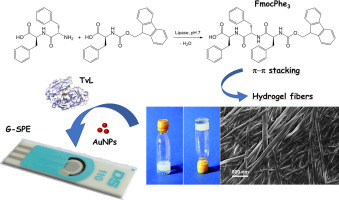当前位置:
X-MOL 学术
›
Microchem. J.
›
论文详情
Our official English website, www.x-mol.net, welcomes your
feedback! (Note: you will need to create a separate account there.)
Evaluation of novel Fmoc-tripeptide based hydrogels as immobilization supports for electrochemical biosensors
Microchemical Journal ( IF 4.9 ) Pub Date : 2018-03-01 , DOI: 10.1016/j.microc.2017.10.002 Giovanni Fusco , Laura Chronopoulou , Luciano Galantini , Andrea Zerillo , Zulkarnain M. Rasik , Riccarda Antiochia , Gabriele Favero , Andrea D'Annibale , Cleofe Palocci , Franco Mazzei
Microchemical Journal ( IF 4.9 ) Pub Date : 2018-03-01 , DOI: 10.1016/j.microc.2017.10.002 Giovanni Fusco , Laura Chronopoulou , Luciano Galantini , Andrea Zerillo , Zulkarnain M. Rasik , Riccarda Antiochia , Gabriele Favero , Andrea D'Annibale , Cleofe Palocci , Franco Mazzei

|
Abstract The immobilization procedure is one of the key factors affecting the electron transfer based biosensors performance. It must assure both the enzyme retention activity and an efficient communication between the redox center of the enzyme and the electrode surface. In this regard, hydrogels are attractive materials due to their three-dimensional hydrophilic networks and their high-water concentration, promoting the biomolecule long-term stability and providing a suitable scaffold for trapping. To this aim, we have synthesized a gelling tripeptide Fluorenylmethyloxycarbonyl-triphenylalanine (FmocPhe 3 ) produced starting from Fmoc-phenylalanine and diphenylalanine by the catalytic activity of Lipase in water and characterized its performance as a new immobilization support for biosensors. For this purpose, we have evaluated the main bioelectrochemical properties of Trametes versicolor Laccase (TvL) immobilized within the hydrogel and a hydrogel-nanocomposite structure in the presence of gold nanoparticles (AuNPs). Either the Fmoc and the benzyl rings inside the tripeptide structure contributed to the hydrogel network formation by π-π stacking interactions, which promoted the physical entrapment of Laccase as well as the interaction with the carbon-based electrode surface. Furthermore, the π-electrons flow throughout the tripeptide based hydrogel allowed a good electron transfer between the immobilized enzyme and the electrode. The obtained results showed a significative increase in the hydrogel nanocomposite-based graphite biosensor performance with respect to those obtained with the hydrogel-based graphite biosensor. The experimental results, in terms of analytical performance and costs, assessed the possible use of FmocPhe 3 based hydrogels in the development of electrochemical biosensors.
中文翻译:

新型 Fmoc-三肽基水凝胶作为电化学生物传感器固定载体的评价
摘要 固定过程是影响基于电子转移的生物传感器性能的关键因素之一。它必须确保酶的保留活性和酶的氧化还原中心与电极表面之间的有效连通。在这方面,水凝胶由于其三维亲水网络和高水浓度而成为有吸引力的材料,可促进生物分子的长期稳定性并提供合适的捕获支架。为此,我们通过脂肪酶在水中的催化活性,从 Fmoc-苯丙氨酸和二苯丙氨酸开始合成了一种胶凝三肽 Fluorenylmethyloxycarbonyl-triphenylalanine (FmocPhe 3 ),并表征了其作为生物传感器的新型固定载体的性能。以此目的,我们评估了固定在水凝胶中的变色栓菌漆酶(TvL)的主要生物电化学特性,以及在金纳米粒子(AuNP)存在下的水凝胶-纳米复合结构。三肽结构中的 Fmoc 和苄基环都通过 π-π 堆积相互作用促进了水凝胶网络的形成,这促进了漆酶的物理包埋以及与碳基电极表面的相互作用。此外,整个基于三肽的水凝胶的 π 电子流允许固定化酶和电极之间的良好电子转移。获得的结果表明,与使用基于水凝胶的石墨生物传感器获得的性能相比,基于水凝胶纳米复合材料的石墨生物传感器的性能显着提高。实验结果,
更新日期:2018-03-01
中文翻译:

新型 Fmoc-三肽基水凝胶作为电化学生物传感器固定载体的评价
摘要 固定过程是影响基于电子转移的生物传感器性能的关键因素之一。它必须确保酶的保留活性和酶的氧化还原中心与电极表面之间的有效连通。在这方面,水凝胶由于其三维亲水网络和高水浓度而成为有吸引力的材料,可促进生物分子的长期稳定性并提供合适的捕获支架。为此,我们通过脂肪酶在水中的催化活性,从 Fmoc-苯丙氨酸和二苯丙氨酸开始合成了一种胶凝三肽 Fluorenylmethyloxycarbonyl-triphenylalanine (FmocPhe 3 ),并表征了其作为生物传感器的新型固定载体的性能。以此目的,我们评估了固定在水凝胶中的变色栓菌漆酶(TvL)的主要生物电化学特性,以及在金纳米粒子(AuNP)存在下的水凝胶-纳米复合结构。三肽结构中的 Fmoc 和苄基环都通过 π-π 堆积相互作用促进了水凝胶网络的形成,这促进了漆酶的物理包埋以及与碳基电极表面的相互作用。此外,整个基于三肽的水凝胶的 π 电子流允许固定化酶和电极之间的良好电子转移。获得的结果表明,与使用基于水凝胶的石墨生物传感器获得的性能相比,基于水凝胶纳米复合材料的石墨生物传感器的性能显着提高。实验结果,











































 京公网安备 11010802027423号
京公网安备 11010802027423号